#edible wilds
Text
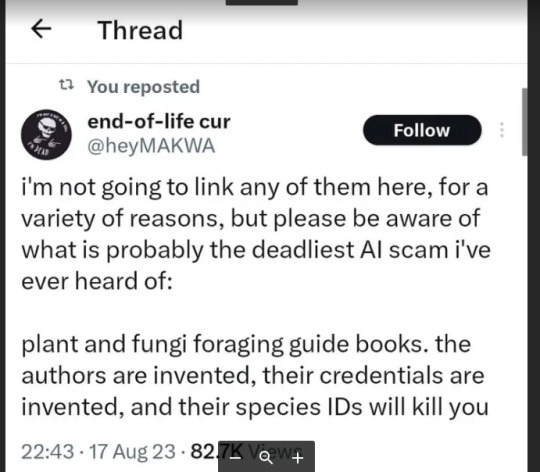
ETA: I wrote up a guide on clues that a foraging book was written by AI here!
[Original Tweet source here.]
[RANT AHEAD]
Okay, yeah. This is a very, very, very bad idea. I understand that there is a certain flavor of techbro who has ABSOLUTELY zero problem with this because "AI is the future, bro", and we're supposed to be reading their articles on how to use AI for side hustles and all that.
I get that ID apps have played into people's tendency to want quick and easy answers to everything (I'm not totally opposed to apps, but please read about how an app does not a Master Naturalist make.) But nature identification is serious stuff, ESPECIALLY when you are trying to identify whether something is safe to eat, handle, etc. You have to be absolutely, completely, 100000% sure of your ID, and then you ALSO have to absolutely verify that it is safely handled and consumed by humans.
As a foraging instructor, I cannot emphasize this enough. My classes, which are intended for a general audience, are very heavy on identification skills for this very reason. I have had (a small subsection of) students complain that I wasn't just spending 2-3 hours listing off bunches of edible plants and fungi, and honestly? They can complain all they want. I am doing MY due diligence to make very sure that the people who take my classes are prepared to go out and start identifying species and then figure out their edibility or lack thereof.
Because it isn't enough to be able to say "Oh, that's a dandelion, and I think this might be an oyster mushroom." It's also not enough to say "Well, such-and-such app says this is Queen Anne's lace and not poison hemlock." You HAVE to have incredibly keen observational skills. You HAVE to be patient enough to take thorough observations and run them through multiple forms of verification (field guides, websites, apps, other foragers/naturalists) to make sure you have a rock-solid identification. And then you ALSO have to be willing to read through multiple sources (NOT just Wikipedia) to determine whether that species is safely consumed by humans, and if so if it needs to be prepared in a particular way or if there are inedible/toxic parts that need to be removed.
AND--this phenomenon of AI-generated crapola emphasizes the fact that in addition to all of the above, you HAVE to have critical thinking skills when it comes to assessing your sources. Just because something is printed on a page doesn't mean it's true. You need to look at the quality of the information being presented. You need to look at the author's sources. You need to compare what this person is saying to other books and resources out there, and make sure there's a consensus.
You also need to look at the author themselves and make absolutely sure they are a real person. Find their website. Find their bio. Find their social media. Find any other manners in which they interact with the world, ESPECIALLY outside of the internet. Contact them. Ask questions. Don't be a jerk about it, because we're just people, but do at least make sure that a book you're interested in buying is by a real person. I guarantee you those of us who are serious about teaching this stuff and who are internet-savvy are going to make it very easy to find who we are (within reason), what we're doing, and why.
Because the OP in that Tweet is absolutely right--people are going to get seriously ill or dead if they try using AI-generated field guides. We have such a wealth of information, both on paper/pixels and in the brains of active, experienced foragers, that we can easily learn from the mistakes of people in the past who got poisoned, and avoid their fate. But it does mean that you MUST have the will and ability to be impeccably thorough in your research--and when in doubt, throw it out.
My inbox is always open. I'm easier caught via email than here, but I will answer. You can always ask me stuff about foraging, about nature identification, etc. And if there's a foraging instructor/author/etc. with a website, chances are they're also going to be more than willing to answer questions. I am happy to direct you to online groups on Facebook and elsewhere where you have a whole slew of people to compare notes with. I want people's foraging to be SAFE and FUN. And AI-generated books aren't the way to make that happen.
#foraging#mushroom foraging#plant foraging#mushrooms#edible plants#edible mushrooms#wild foods#food#nature#AI#fungus#fungi#poisonous mushrooms#poisonous plants#botany#mycology#rant
4K notes
·
View notes
Text
In honor of a bunch of my friends being served iris rhizomes instead of daylily bulbs at a skills event and puking their guts out all night, here is a friendly reminder about wild edibles:
Do not eat any wild edibles that are at all new to you or you are even a little uncertain about without double and triple checking the ID with a trusted, professional resource. ABSOLUTELY DO NOT feed wild edibles to anyone else that you haven't repeatedly IDed and eaten yourself with no problems.
#there is very little space to be uncertain with wild edibles ESPECIALLY when you are sharing them#(also anyone who makes THAT particular mistake needs to go back to the drawing board & learn how to look at plants because how do you even-#wild edibles#foraging#plantblr#thank god it wasnt a more dangerous mistake and all that happened was 50% of the group throwing up for a night#raincoats speaks
2K notes
·
View notes
Text

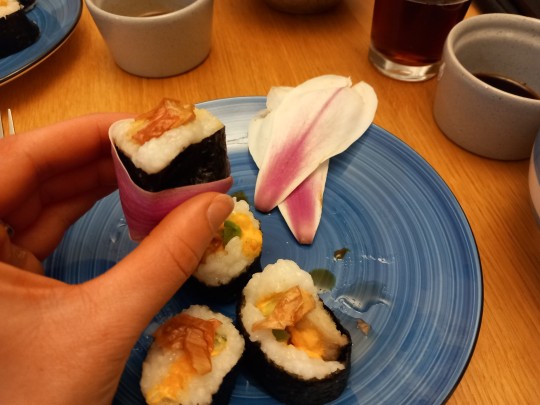
This is how I use pickled magnolia petals - as ginger on homemade sushi! I also love it enough to enjoy wrapping a fresh blossom around each piece to eat it too.
The miso soup features wild garlic, another wonderful spring time edible.
167 notes
·
View notes
Text

Do you like ginger and/or cardamom?
Do you also like free spices?
WELL HI let me introduce you to magnolia buds! Yes, the same buds that eventually become those lovely pink flowers you see growing on trees every spring.
Magnolia flowers are edible at all stages, but when you pick them like this just before they open, they are PERFECT for drying and using as a spice. If the buds are already open, don’t bother. I don’t know what it is about the petals, but they do NOT dry well and the smell becomes almost fishy.
I slice the buds open lengthwise, and separate any thick outer layers before drying. An oven won’t work for this unfortunately — the flavor is really too delicate. I put them in a dehydrator on its lowest setting for most consistent results, but air drying will also work. The only thing about that is it’s very important that the buds remain dry. Any moisture and you risk ruining a whole batch.
They shrink a lot once they’re fully dry, so I don’t bother crushing them up when finished. I store them in a clean, dry mason jar and they last easily for a few months (if I don’t use them before then)! Use anywhere you would ginger or cardamom – they make an excellent addition to cookies and spice cakes!
* Always forage responsibly and NEVER eat anything you aren’t 100% sure of. When in doubt, throw it out! *
193 notes
·
View notes
Text
I desperately need more botany/gardening/solarpunk/foraging posts that aren’t so fucking American-centric
“European plants are invasive” okay, in America— but which ones are invasive HERE, like are Spanish species invasive to England? Are French plants invasive to England??
#we’re a fucking island but we’re also in Europe and I need more shit about wildflowers or invasive species or edible foraging plants in UK#wild flowers#wildflowers#england#scotland#ireland#wales#including those three too cause it’s probably a very similar issue#I mean maybe I’m just not looking in the right places but everything I ever come across is American or Canadian#UK#solarpunk#botany#foraging#foragecore#foraged food#🪲#botanic garden#garden design
246 notes
·
View notes
Text


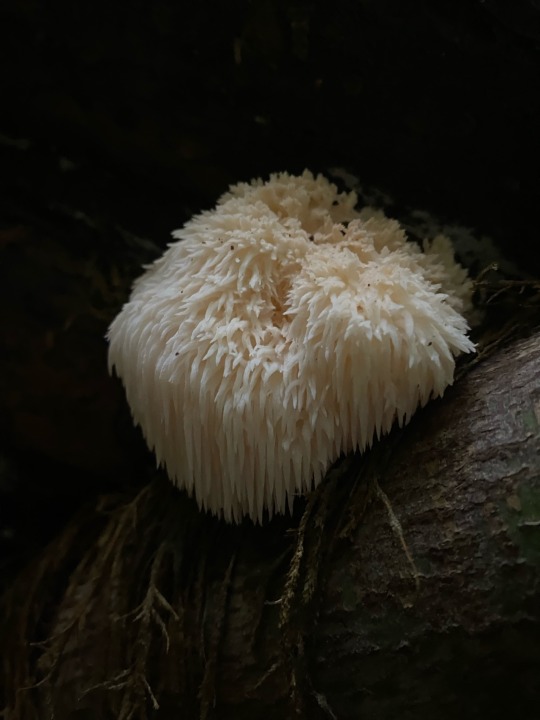
papa bear..
moma bear..
baby bear..
Hericium erinaceus..some prefer different nicknames but it reminds me of a bears head at maturity..fruiting reliably on a fallen maple log..
272 notes
·
View notes
Text
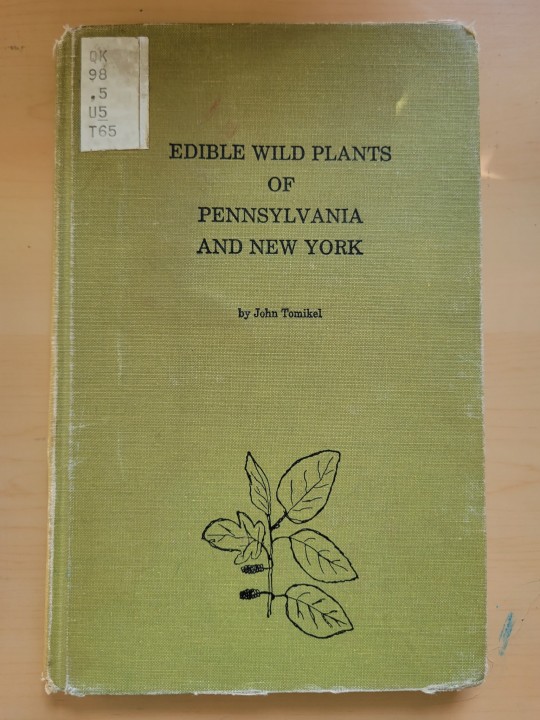



At the beginning of the summer, I had big plans to better my plant ID knowledge and foraging, and staggered home from the library with a giant stack of guidebooks. Which went entirely unread until now, unfortunately. Some of them were older books which I'm flipping through more out of curiosity and an appreciation for line drawings rather than for practical advice - this one is from 1973 and I'm supremely charmed by the author's voice, particularly his attitude of "just because I'm writing the book you're reading about edible plants doesn't mean you should trust anything I say."
298 notes
·
View notes
Text
phlob milk irl

#its technically edible#but i wouldnt drink it#jamblr#animal jam#ajpw#play wild#animal jam play wild
169 notes
·
View notes
Text
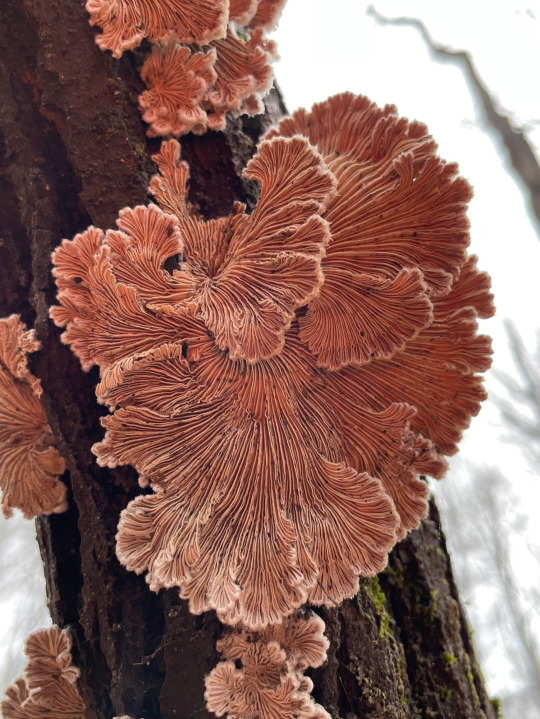
Here are some nice mushrooms
#goblincore#mushrooms#cottagecore#fairycore#mushies#fairy aesthetic#wild mushrooms#cottage aesthetic#fungi#fungus#mushroom photography#fungicore#fungi photography#fungifanatic#wild fungi#fungifreaks#naturecore#nature photography#edible mushrooms
81 notes
·
View notes
Text
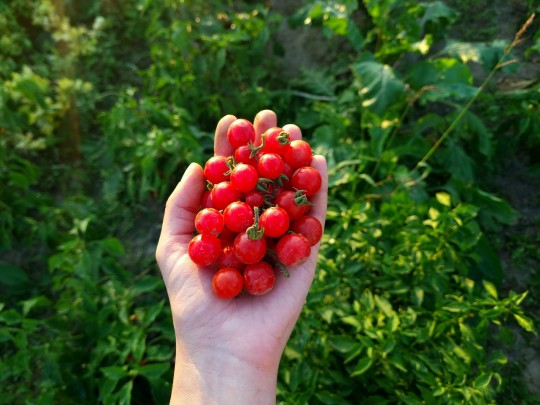
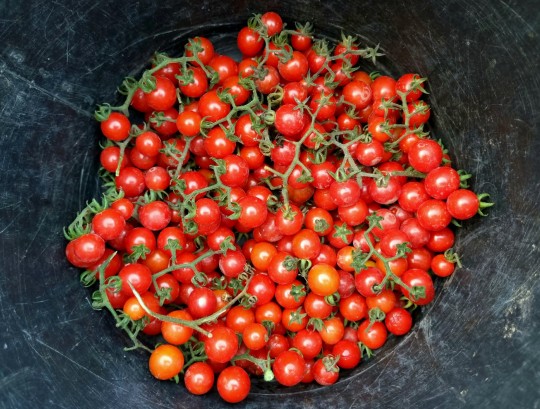
My favorite tomatoes.
I panicked a bit when it was time to sow them, because I didn't save any seeds last year and from my old ones all I could find was a baggie from 2016, so I didn't know how they'd germinate, but here they are.
#wild tomatoes#orchard garden#harvest#heirloom tomatoes#tomatoes#gardeners on tumblr#grow your own food#gardenblr#edible gardening#garden#gardenblog#gardening#gardencore
233 notes
·
View notes
Text
hello. let's play a game. i want you to describe how nagito komaeda acts in sdr2. if you use the words "crazy," "deranged," or "psychotic," you will be dropped into a pit of venemous snakes and beaten to death with hammers. let's begin
#chatter#sdr2#nagito komaeda#i have not been delusional abt him since 2020 for people to misunderstand him as bad as 98% of the fandom does .#yall remember when it was called delusional attatchments. wild#unrelated tag ramble obver this edible aint shit
90 notes
·
View notes
Text
I am all for creative sushi, but not when the creator doesn't fully understand the ingredients. A sushi restaurant in Montana served people sushi with raw and very undercooked morel (Morchella spp.) mushrooms on it. Over fifty people ended up sick with gastrointestinal upset, and two people actually died. Other restaurants that served the same batch of morels, fully cooked, had no such issues, and there was no evidence that there was any mishandling of the morels that could have caused a bacterial or other contamination. So it's pretty clear that the raw morels themselves were to blame.
Yes, there are a few wild mushroom species you can eat raw, and only in small amounts). No, Morchella are not among them. Morels have a toxin in them that's neutralized by cooking; Paul Stamets theorized that it's hydrazine, but no one has been able to isolate hydrazine in a morel yet so that's not a done deal. Whatever it is, there's enough of it that it tends to give people nasty gastrointestinal upset when they eat raw morels, even in small quantities. This is the first I've heard of people dying from it.
It's not the only time I've heard of people dying from consuming a commonly-considered-edible mushroom, though. There were two separate incidents--2004 and 2009--in which several people who ate angel wing mushrooms (Pleurocybella porrigens) died of encephalopathy. Now, it did turn out that most of the people sickened had pre-existing liver and/or kidney issues. And a 2011 study identified an unstable amino acid, now named Pleurocybellaziridine, as the possible fatal factor that was found in large quantities in angel wings. It could be that the culprits were flushes of these mushrooms with abnormally high amounts of Pleurocybellaziridine. But you can't tell how much of a given metabolite a given mushroom has just by looking at it, and so that raises enough of an alarm for me personally that as a forager I just put angel wings on the "do not eat" list.
Will I continue to eat morels? Yes. The toxicity associated with raw morels has been known for a long time, and there have been no recorded issues with thoroughly cooked morels (the angel wings were also cooked, meaning the toxin is not thermolabile.) And as mentioned before, almost any edible wild mushroom is going to give you gastrointestinal issues if you eat it raw. The mushrooms you get at the store are a weird outlier that can be safely eaten raw. And by the way, button mushrooms, criminis, and portobellos are all the same species--Agaricus bisporus--at different stages of development.
This is why I emphasize in my foraging classes that you should always cook your wild mushrooms thoroughly, and if you're trying a new species for the first time only eat a small amount and then wait a few days to make sure you don't have any reactions. As the saying goes, there are old mushroom hunters and there are bold mushroom hunters, but there are no old, bold mushroom hunters.
#mushrooms#mushroom hunting#mushroom foraging#foraging#edible mushrooms#morels#Morchella#fungi#fungus#mycology#poisonous mushrooms#nature#food#foragers#wild mushrooms#sushi#Montana#food safety
1K notes
·
View notes
Text
comprehensive list of edible flowers to celebrate spring!:
magnolias (they taste like ginger)
dandelions (only eat the yellow stuff not the bitter green stuff)
violets (if u make tea from them then add lemon it turns pink! tastes earthy and mildly sweet)
lilac (they're bitter on their own but if you put a flower head in cold water for a couple hours it makes the most divine, refreshing spring drink)
marigolds (kinda peppery, v fun in salads-- used as a sub for saffron in cooking)
rose (the og edible flower, most are very floral and taste like how they smell, they make for an excellent tea as well!)
nasturnium (very peppery, almost like horseradish-- not my fav but if u like it go off i guess)
peonys (mildly sweet, floral flavor and fun to eat off the bush)
wood sorrel (the flowers are small so it barely made it onto this list but they taste like little bombs of green apple so go eat them--also eat the leaves!)
daisy (some say the yellow center tastes like pineapple-- i think its a bit of a stretch but they are sweet and tasty nonetheless!)
red clover (the flower heads can be white or pink-- the pink ones are the sweeter ones)
redbud (these grow on trees in v early spring-- they taste exactly like snap peas.)
always remember to do research before eating any wild plant, and always be 100% certain that u have the right one-- also don't eat stuff that might be contaminated with pesticides
#plants#flowers#wild edibles#edible flowers#nature#cottagecore#flower aesthetic#gremlincore#ive seen a lot of ppl talking abt how the leaves of dandelion are edible#i know#but raw theyre bitter
337 notes
·
View notes
Text

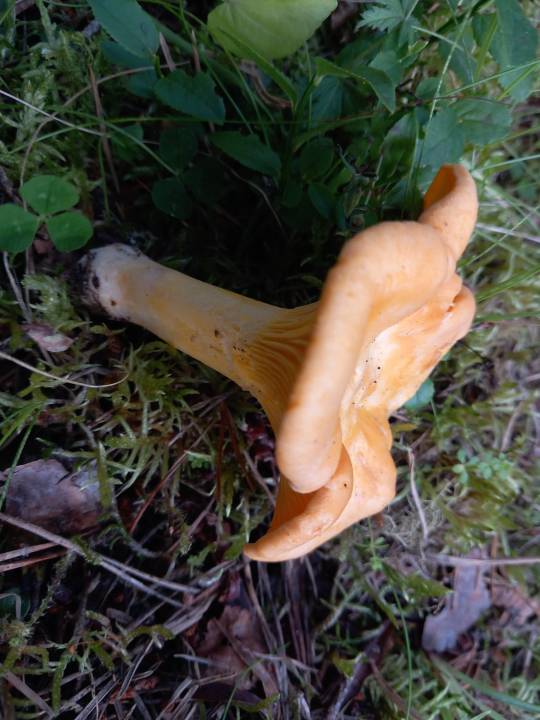
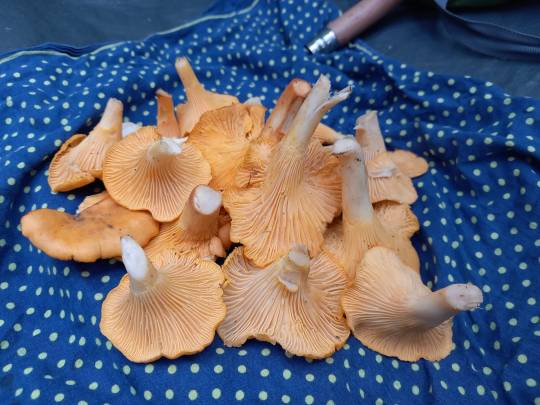

Abernethy Forest, Scotland, UK, August 2023
Chanterelles (Cantharellus cibarius)
I've been hiking and wild camping in Scotland's gorgeous ancient woodland and have found SO many amazing mushrooms - I can't wait to sort through pics and post for you all to see!
Most excitingly though, I found LOADS of chanterelles, which I've only ever found one or two of before. I gathered a potful (more than pictured here, and still leaving most of what I saw) and they made an amazing addition to my campside ramen. Tonight some more will go in a pasta sauce, then I'm planning a risotto for the rest :)
These mushrooms are delicious and highly sort after. They can be recognised by their irregular caps, apricot smell, veins on the underside rather than true gills, and white flesh which can be seen when they're cut in two.
There are two main potential confusions to be aware of:
Jack o Lanterns (Omphalotus olearius) - these are similarly sized orange mushrooms which might be mistaken for chanterelles at first. However, they clearly have gills on the underside rather than veins. These fungi are poisonous.
False chanterelle (Hygrophoropsis aurantiaca) - these are a more plausible confusion, as the name suggests. They have true gills, but they look a lot like the veins of the chanterelle.
They can be distinguished from 'true' chanterelles by their yellow-orange flesh when they are cut open, their lack of apricot smell, their darker cap centres and more regular caps. The best way to distinguish them is to cut them in half - you will see the colour of the flesh, and also whether there is a margin between the cap flesh and the gills. True chanterelles do not have this, whereas false chanterelles will show that the gill is separate to the cap. Young chanterelles and false chanterelles really do look quite similar, so be careful! Luckily, false chanterelles aren't seriously poisonous - they produce the symptoms of mild food poisoning, and there are some dubious reports of psychedelic effects.
#fungi#mycology#chanterelles#foraging#wild food#edible fungi#Cantharellus cibarius#food#vegan#orange fungi#potential confusions
242 notes
·
View notes
Text


Pawpaws - not papayas - the only tropical fruit indigenous to the temperate east coast of America.
At the Baltimore Farmers Market
#baltimore#maryland#charm city#the baltimore you don't know#pawpaw#papaya#NOT papaya#native fruit#native food#wild edibles#fruit#farmers market
196 notes
·
View notes
Text


Plant of the Day
Saturday 13 January 2024
The tropical herbaceous perennial plant Etlingera elatior (torch ginger, ginger flower, red ginger lily, torchflower, torch lily, wax flower, wild ginger) needs a warm, humid climate. It produces a spreading clump with dramatic flowers which can be eaten when in bud having a crisp and succulent texture.
Jill Raggett
#Etlingera#torch ginger#ginger flower#red ginger lily#torchflower#torch lily#wax flower#wild ginger#herbaceous#perennial#tropical glasshouse#tropical#red flowers#edibles#plants#horticulture#gardens#herbaceousperennial
147 notes
·
View notes